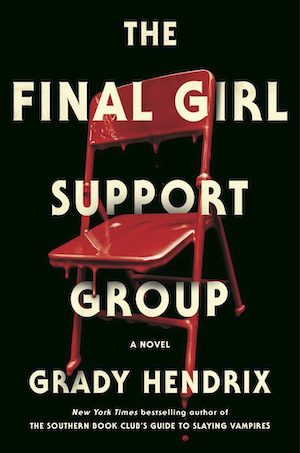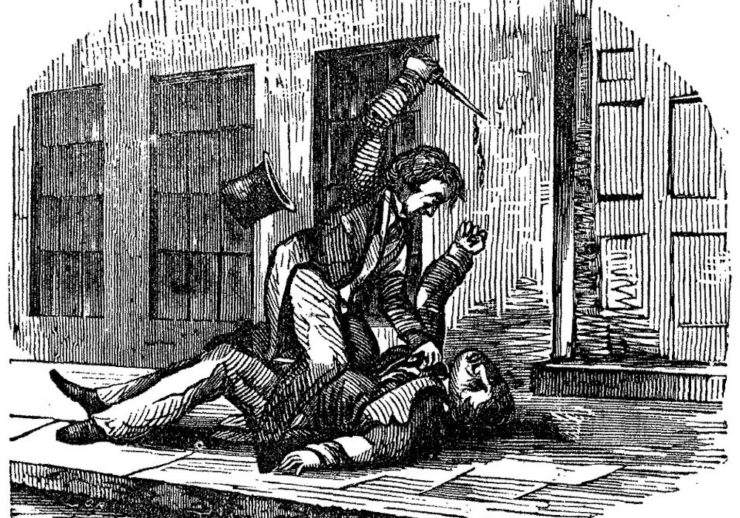You can’t talk about murder books without talking about true crime. Books and movies about real life murders take up a large slice of our pop culture food pyramid, and we live in a world where actors regularly win awards for playing real-life criminals and murderers, so any murmurs that exploiting actual crimes and actual victims for profit is somehow distasteful feels like closing the barn door long after the horse has left the premises. There have been true crime podcasts, books, TV series, movies, magazines, radio shows, and even board games. No one feels any shame about it, and why should they? Chatting about murder victims is a great bonding experience! Want to start a conversation? Just ask me if I listen to “My Favorite Murder.”
Most true crime entertainment gets consumed for pure thrills, but we’re all uncomfortable with things being fun, so ask why we love our true crime and you’ll get lots of guff about “educating oneself,” “fascination with the dark side,” and “to learn how to spot danger signs” because everything has to have some nutritional value or we feel guilty. As it turns out, this blend of defensiveness with a hunger for sensationalism all seems to have started in Germany a long, long time ago…
In late 15th-century Germany, local printers learned that publishing topical news pamphlets made money, but it took them almost 50 years to realize that the real cash was in reporting crime. Providing further proof that sanctimony and true crime have gone hand in hand all the way back to the beginning, many of these pamphlets were written by members of the clergy and emphasized that the road to hacking up your family began with disobeying your parents, cursing, and drinking booze. These morphed into broadsides written in rhyme, each focusing on an individual crime, designed to be sung along to the tune of the most popular hymns of the day.
Publishers had zero scruples, often releasing 20- and 40-year-old crimes as breaking news in order to recycle the grisly details, and the text oozed with pathetic flourishes, such as descriptions of children begging their mother for their lives before she sank an axe into their skulls. The tone was:
“My dearest reader, this is unfortunately, may God have mercy, one piece of horrifying news after another…so that my heart nearly breaks and my eyes fill with tears.”
But apparently not so much that I can’t see to write it all down.
Did I mention they were illustrated? One 1573 rape/murder inspired four different pamphlets, two featuring diagrams showing how the body was dissected into 16 pieces, the parts laid out like a jigsaw puzzle.
In colonial America, thousands of people traveled dozens of miles to watch sodomites, murderers, and pickpockets executed. Copies of the execution sermons were always for sale so you could bring them home and wallow in the sinful details with your neighbors. In 16th- and 17th-century England, “last goodnight” ballads told the tragic, first-person tales of criminals facing their last night before execution as they sang their regrets about the hard lives that led them to this end. Ballads like “The Lamentation of Master Page’s Wife” by Thomas Deloney found pity for Eulalia Glandfield, forced to marry against her will and who conspired with her lover to kill her husband. It condemned her for her crime, but also made sure to point out that her greedy parents, who forced her into this marriage, also bore part of the blame.
Ballads soon had to compete with the Newgate Calendar. Originally a simple calendar of executions kept by Newgate Prison, it eventually became The Newgate Calendar: Or, Malefactors’ Bloody Register, the most widely read book in England for more than a century. Noted ravishers of women, like the aptly named James Booty, had their lives spun off into solo pamphlets, but the regular calendar still featured a cavalcade of criminals, stuffed with heinous details of their bloody crimes and daring escapes from the law, complete with a “crime does not pay” Dragnet-style deadpan, like this poem that accompanied the frontispiece of one edition over an illustration of a mother handing her tiny son a copy of the Calendar:
The anxious Mother with a Parents Care,
Presents our Labours to her future Heir
“The Wise, the Brave, the temperate and the Just,
Who love their neighbour, and in God who trust
Safe through the Dang’rous paths of Life may Steer,
Nor dread those Evils we exhibit Here.”
In the 1840s, tiny regional presses all across America ditched the religious angle of the execution sermons and went full Newgate, only better, publishing cheap pamphlets of actual criminal confessions. Aimed at local audiences, they opened with the standard disclaimer that they were designed for moral instruction and spiritual education not for cheap titillation, before cheaply titillating at every turn. With families and friends prevented from visiting condemned criminals, many were written by those with guaranteed access: Protestant clergy (Catholic priests couldn’t, due to the sanctity of confession), and they provided a nice side hustle for some ministers. However, many were written (or dictated) by the killers themselves. John Lechler, for example, was a Pennsylvania man who caught his wife with his neighbor, strangled her, then chased the pantsless neighbor across the street, fired at him through his front door, and accidentally killed his wife. He wrote his pamphlet to “raise a small pittance for the assistance of those innocent orphans who are rendered destitute by the crime of their father” sounding a sad note before the reader remembers that they’re innocent orphans because their father strangled their mother. It’s a strange echo of what Amy Fisher’s lawyer said when people questioned the propriety of a perpetrator like Fisher selling the rights to her story, “She needs the money to pay legal costs and to finance her college education.”
Amy Fisher never actually went to college, just like Lechler actually wrote his confession to beat another, pirated confession to market, claiming that his jailer had forced Lechler to give him a confession. “I am his poor prisoner, in chains to write a history for him, which he intends to have published also,” Lechler whines. His jailer also didn’t plan to share any of the money, either with Lechler or with the “poor orphans.”
Buy the Book


The Final Girl Support Group
Some criminals dictated or wrote their confessions to correct the public record, with one using his confession to admit he committed bestiality and incest, but he was definitely innocent of a long list of lesser crimes. Another wrote his confession to go on the record that he had NOT sold his body to science for rum and instead wanted to be buried by his brother. It’s an understandable wish when you consider that around the same time, John Johnson of New York City was executed for murder, then had his body hooked up to a battery in the theater of the College of Physicians and Surgeons, where scientists used electric current to make his muscles dance, his mouth twitch, and his heart contract for… science reasons. Presumably.
By the middle of the 18th century, regional presses started consolidating and the first-person confessional format was abandoned for a third-person editorial voice that substituted gruesome effects for personal immediacy. Books from houses like G.B. Zeiber (Philadelphia), A.R. Orton (New York) and Erastus Elmer Barclay (New Orleans) published stories for a national audience that trafficked in true crime full of sensational details like corpses found with their unborn children beneath them and lists of the contents of the victims’ stomachs. These accounts often took a break in the middle of a particularly graphic scene to breathlessly recommend that if the reader liked this book they should also read another of the publisher’s recent true crime books.
Murder ballads had never been out of style and in the later 19th century, they made a resurgence in sheet music, usually centered on crimes of passion with female victims. The beheading of the pregnant Pearl Bryan in 1896 spawned three different and distinct ballads, none of which mention the fact that she probably died of a botched abortion performed by her dental student boyfriend who then sawed off her head in a failed attempt to prevent her identification. In the ’20s and ’30s, female singers began recording murder ballads, a trend that culminated in the ’40s when singers like Patsy Montana brought back the confessional format for songs about women killing men, like “I Didn’t Know the Gun Was Loaded”:
I didn’t know the gun was loaded
And I’m so sorry, my friend
I didn’t know the gun was loaded
And I’ll never, never do it again
Technology continued to reinvigorate true crime when, in 1936, actor Phillips Lord, who had achieved national fame playing the backwoods philosopher Seth Parker on the NBC radio show Sunday Evenings with Seth Parker, teamed up with the head of the FBI, J. Edgar Hoover, to produce a true crime radio show. The first season of Gang Busters was a snooze, mostly due to Hoover’s endless moralizing and sanctimony. Lord ditched the G-man for season two and turned everything else up to eleven: more sound effects! More gore! More action! More excitement! The intelligentsia regarded Parker’s listeners as working-class mouth breathers, but it didn’t matter. Gang Busters captured populist anger at banks and law enforcement and became a massive hit that ran until 1957. The start of every show was so loud, exciting, and over-the-top that to this day when someone says something “comes on like gangbusters” they’re referring to a radio show that went off the air before they were even born.
True crime reduced its moralizing to a mere fig leaf for most of the 20th century, swapping religious piety for secular scolding of fast women and dangerous men. Gaining market share around the same time as Gang Busters was True Detective Magazine, founded in 1924 by Bernarr MacFadden, the heartless health nut who ditched the fiction in his magazine when he realized the real nutrition was in the nonfiction. Generally as reputable as a sideshow, True Detective occasionally exposed injustices—as in its 1931 series, “I Am a Fugitive From a Chain Gang”—but it mostly delivered screaming headlines like “Flesh Streets of ‘Frisco,” “Saturday Night is the Devil’s Night Out,” and “Incredible Case of the Killer Who Left the Corpse at the Foot of Her Bed for 8 Years!” Macfadden, a notorious creep who let two of his eight children die for treatable conditions because he thought doctors were quacks, died rather unsurprisingly in 1955 after refusing medical intervention for a digestive disorder. His magazine lasted for 40 more years and is almost single-handedly responsible for true crime’s current reputation as tabloid trash.
You know what’s respectable? Books! And several authors tried to comb true crime’s hair and make it put on a tie well before it became the hottest category in publishing during the late ’80s. Norman Mailer’s The Executioner’s Song and Truman Capote’s In Cold Blood get a lot of the credit, but as always, it’s women who did the hard work.
Next Week: True crime is literature! No, it’s trash! No, it’s literature!
Grady Hendrix is the award-winning, New York Times bestselling author of The Southern Book Club’s Guide to Slaying Vampires, along with a bunch of other books and movies. His new novel is The Final Girl Support Group (out July 13) and you can find more dumb facts about him over at gradyhendrix.com.










